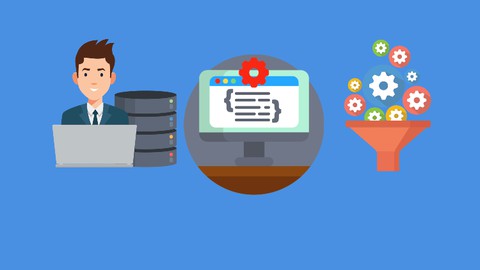
Software Developer – C#/OOP/ASP.NET MVC/MS SQL/SQL Server
Software Developer – C#/OOP/ASP.NET MVC/MS SQL/SQL Server, available at $54.99, has an average rating of 4.55, with 133 lectures, based on 147 reviews, and has 14733 subscribers.
You will learn about Create Console Apps Create Windows Forms Apps Create ASP DOT NET Core App Create your own classes Learn Object Oriented Programming Concepts with C# Learn C# Fundamentals Create database driven apps Learn MS SQL Setup SQL Server Setup Visual Studio Create ASP DOT NET MVC APP This course is ideal for individuals who are Beginner C# Developers or Beginners to SQL | MS SQL or Beginners to SQL Server It is particularly useful for Beginner C# Developers or Beginners to SQL | MS SQL or Beginners to SQL Server.
Enroll now: Software Developer – C#/OOP/ASP.NET MVC/MS SQL/SQL Server
Summary
Title: Software Developer – C#/OOP/ASP.NET MVC/MS SQL/SQL Server
Price: $54.99
Average Rating: 4.55
Number of Lectures: 133
Number of Published Lectures: 133
Number of Curriculum Items: 133
Number of Published Curriculum Objects: 133
Original Price: $119.99
Quality Status: approved
Status: Live
What You Will Learn
- Create Console Apps
- Create Windows Forms Apps
- Create ASP DOT NET Core App
- Create your own classes
- Learn Object Oriented Programming Concepts with C#
- Learn C# Fundamentals
- Create database driven apps
- Learn MS SQL
- Setup SQL Server
- Setup Visual Studio
- Create ASP DOT NET MVC APP
Who Should Attend
- Beginner C# Developers
- Beginners to SQL | MS SQL
- Beginners to SQL Server
Target Audiences
- Beginner C# Developers
- Beginners to SQL | MS SQL
- Beginners to SQL Server
C# (pronounced “See Sharp”) is a modern, object-oriented, and type-safe programming language. C# enables developers to build many types of secure and robust applications that run in .NET. C# has its roots in the C family of languages and will be immediately familiar to C, C++, Java, and JavaScript programmers.
C# is an object-oriented, component-oriented programming language. C# provides language constructs to directly support these concepts, making C# a natural language in which to create and use software components. Since its origin, C# has added features to support new workloads and emerging software design practices. At its core, C# is an object-oriented language. You define types and their behaviour.
C# programs run on .NET, a virtual execution system called the common language runtime (CLR) and a set of class libraries. The CLR is the implementation by Microsoft of the common language infrastructure (CLI), an international standard. The CLI is the basis for creating execution and development environments in which languages and libraries work together seamlessly.
Object-oriented programming (OOP) is the core ingredient of the .NET framework. OOP is so important that, before embarking on the road to .NET, you must understand its basic principles and terminology to write even a simple program. The fundamental idea behind OOP is to combine into a single unit both data and the methods that operate on that data; such units are called an object. All OOP languages provide mechanisms that help you implement the object-oriented model. They are encapsulation, inheritance, polymorphism and reusability.
Encapsulation
Encapsulation binds together code and the data it manipulates and keeps them both safe from outside interference and misuse. Encapsulation is a protective container that prevents code and data from being accessed by other code defined outside the container.
Inheritance
Inheritance is the process by which one object acquires the properties of another object. A type derives from a base type, taking all the base type members fields and functions. Inheritance is most useful when you need to add functionality to an existing type. For example all .NET classes inherit from the System Object class, so a class can include new functionality as well as use the existing object’s class functions and properties as well.
Polymorphism
Polymorphism is a feature that allows one interface to be used for a general class of action. This concept is often expressed as “one interface, multiple actions”. The specific action is determined by the exact nature of circumstances.
Reusability
Once a class has been written, created and debugged, it can be distributed to other programmers for use in their own program. This is called reusability, or in .NET terminology this concept is called a component or a DLL. In OOP, however, inheritance provides an important extension to the idea of reusability. A programmer can use an existing class and without modifying it, add additional features to it.
ASP DOT NET is a popular web-development framework for building web apps on the .NET platform.
ASP DOT NET is the open-source version of ASP DOT NET , that runs on macOS, Linux, and Windows. ASP DOT NET Core was first released in 2016 and is a re-design of earlier Windows-only versions of ASP DOT NET .
DOT NET is a developer platform made up of tools, programming languages, and libraries for building many different types of applications.
The base platform provides components that apply to all different types of apps. Additional frameworks, such as ASP DOT NET , extend DOT NET with components for building specific types of apps.
Here are some things included in the DOT NET platform:
-
The C#, F#, and Visual Basic programming languages
-
Base libraries for working with strings, dates, files/IO, and more
-
Editors and tools for Windows, Linux, macOS, and Docker
ASP DOT NET extends the DOT NET platform with tools and libraries specifically for building web apps.
These are some things that ASP DOT NET adds to the DOT NET platform:
-
Base framework for processing web requests in C# or F#
-
Web-page templating syntax, known as Razor, for building dynamic web pages using C#
-
Libraries for common web patterns, such as Model View Controller (MVC)
-
Authentication system that includes libraries, a database, and template pages for handling logins, including multi-factor authentication and external authentication with Google, Twitter, and more.
-
Editor extensions to provide syntax highlighting, code completion, and other functionality specifically for developing web pages
When using ASP DOT NET your back-end code, such as business logic and data access, is written using C#, F#, or Visual Basic.
The SQL Server is a relational database management system from Microsoft. The system is designed and built is to manage and store information. The system supports various business intelligence operations, analytics operations, and transaction processing
SQL stands for Structured Query Language. A query language is a kind of programming language that’s designed to facilitate retrieving specific information from databases, and that’s exactly what SQL does. To put it simply, SQL is the language of databases.
T-SQL, which stands for Transact-SQL and is sometimes referred to as TSQL, is an extension of the SQL language used primarily within Microsoft SQL Server. This means that it provides all the functionality of SQL but with some added extras.
Course Curriculum
Chapter 1: Microsoft Visual Studio Setup
Lecture 1: Introduction
Lecture 2: What is a software developer
Lecture 3: What is C#
Lecture 4: What is Visual Studio
Lecture 5: Minimum Installation Requirements
Lecture 6: Installing Visual Studio
Lecture 7: Visual studio workloads
Lecture 8: Create a basic console app
Lecture 9: Create a basic ASP.NET App
Lecture 10: Creating a Windows Forms App
Lecture 11: Running projects outside visual studio
Lecture 12: Code comments
Chapter 2: C# Essentials
Lecture 1: Basic Data Types
Lecture 2: What is a string
Lecture 3: Data Type Conversion: Part 1
Lecture 4: Data Type Conversion: Part 2
Lecture 5: Converting to string and truncating
Lecture 6: What are Variables
Lecture 7: Guideline to naming variables
Lecture 8: Arrays
Lecture 9: Code Challenge – Arrays
Lecture 10: Conditional statements
Lecture 11: Lists
Lecture 12: List Concatenation
Lecture 13: Dictionaries
Lecture 14: Removing items from dictionaries
Lecture 15: Using conditional statements with dictionaries
Lecture 16: While Loops
Lecture 17: Do While Loops
Lecture 18: For Loops
Lecture 19: Foreach Loops
Lecture 20: Switch Statements
Lecture 21: Basic Arithmetic Operators
Lecture 22: Operator precedence
Lecture 23: Concatenation
Chapter 3: C# Object Oriented Programming -OOP
Lecture 1: What is OOP
Lecture 2: Creating console app
Lecture 3: Creating your own classes
Lecture 4: Adding fields to classes & encapsulation
Lecture 5: Adding properties to fields
Lecture 6: Auto-implemented properties
Lecture 7: Adding methods to classes
Lecture 8: Overloading
Lecture 9: Overriding ToString() method
Lecture 10: Constructors
Lecture 11: Instantiating objects
Lecture 12: Static Keywords
Lecture 13: Inheritance: Creating Parent Class
Lecture 14: Inheritance: Creating Child Class
Lecture 15: Inheritance: Logic for main method
Lecture 16: Polymorphism
Lecture 17: GetType() and typeOf() method
Lecture 18: Abstract Classes and Methods
Chapter 4: ASP.NET CORE
Lecture 1: What is ASP.NET
Lecture 2: ASP Development Models
Lecture 3: What is ASP.NET Core
Lecture 4: What is .NET
Lecture 5: What is MVC
Lecture 6: Create a new ASP.NET Core Web Project
Lecture 7: ASP.NET Core web project structure
Lecture 8: How to run ASP.NET Core Web App project
Lecture 9: Editing a Razor page
Chapter 5: Building an ASP.NET CORE MVC Web App
Lecture 1: Creating a new ASP.NET Core MVC Project
Lecture 2: Editing auto-generated web pages
Lecture 3: Creating a model class
Lecture 4: What is Entity Framework
Lecture 5: Creating Dynamic Pages
Lecture 6: Using Migrations to create database and tables
Lecture 7: Adding items to Nav Bar
Lecture 8: Adding search item to Nav Bar
Lecture 9: Adding Search Form view
Lecture 10: Adding ShowSearchResults Method
Lecture 11: Implementing Security
Lecture 12: Tips to improve app
Lecture 13: Project Code
Chapter 6: Build a Volume Converter
Lecture 1: Project Design
Lecture 2: Create a new windows form project
Lecture 3: Add some controls
Lecture 4: Rename text property controls
Lecture 5: Rename Name Property Controls
Lecture 6: Add logic for event handlers
Lecture 7: Test application
Lecture 8: Customize application
Lecture 9: Run application
Chapter 7: Build a Paint drawing app
Lecture 1: Create a new windows forms project
Lecture 2: Designing the interface : Part 1
Lecture 3: Designing the interface : Part 2
Lecture 4: Create variables and event handlers
Lecture 5: Rename event handler method
Lecture 6: Add logic to enable drawing
Lecture 7: Add logic to enable saving
Chapter 8: Build a music layer
Lecture 1: Create a new windows forms project
Instructors
-
Bluelime Learning Solutions
Making Learning Simple
Rating Distribution
- 1 stars: 3 votes
- 2 stars: 2 votes
- 3 stars: 15 votes
- 4 stars: 58 votes
- 5 stars: 69 votes
Frequently Asked Questions
How long do I have access to the course materials?
You can view and review the lecture materials indefinitely, like an on-demand channel.
Can I take my courses with me wherever I go?
Definitely! If you have an internet connection, courses on Udemy are available on any device at any time. If you don’t have an internet connection, some instructors also let their students download course lectures. That’s up to the instructor though, so make sure you get on their good side!
You may also like
- Top 10 Emotional Intelligence Courses to Learn in December 2024
- Top 10 Time Management Courses to Learn in December 2024
- Top 10 Remote Work Strategies Courses to Learn in December 2024
- Top 10 Freelancing Courses to Learn in December 2024
- Top 10 E-commerce Strategies Courses to Learn in December 2024
- Top 10 Personal Branding Courses to Learn in December 2024
- Top 10 Stock Market Trading Courses to Learn in December 2024
- Top 10 Real Estate Investing Courses to Learn in December 2024
- Top 10 Financial Technology Courses to Learn in December 2024
- Top 10 Agile Methodologies Courses to Learn in December 2024
- Top 10 Project Management Courses to Learn in December 2024
- Top 10 Leadership Skills Courses to Learn in December 2024
- Top 10 Public Speaking Courses to Learn in December 2024
- Top 10 Affiliate Marketing Courses to Learn in December 2024
- Top 10 Email Marketing Courses to Learn in December 2024
- Top 10 Social Media Management Courses to Learn in December 2024
- Top 10 SEO Optimization Courses to Learn in December 2024
- Top 10 Content Creation Courses to Learn in December 2024
- Top 10 Game Development Courses to Learn in December 2024
- Top 10 Software Testing Courses to Learn in December 2024





















